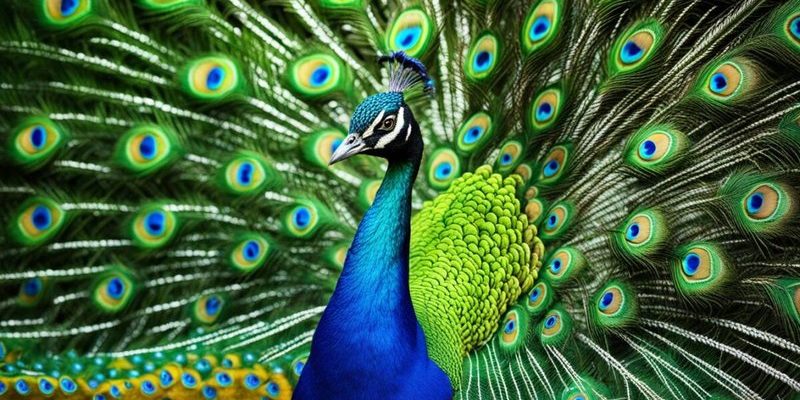
Peacocks, particularly the males, put on a spectacular show to attract females during mating season. It’s not just about looking good; it’s a blend of intricate behaviors and physical displays aimed at impressing a potential mate. So grab your coffee, and let’s dive into the fascinating courtship and mating rituals of the peacock. You’ll be amazed at how these beautiful birds go above and beyond in their quest for love.
The Stunning Display of Feathers
The most iconic feature of the peacock is undoubtedly its iridescent tail feathers, also known as the train. When it’s time for courtship, males spread these feathers into a magnificent fan that can stretch up to six feet wide. Picture a showstopper on stage with a grand finale that leaves the audience breathless.
But it’s not just about size; the eye-catching patterns on the feathers serve an even greater purpose. Each “eye” spot on the feathers is like a badge of honor, signaling to potential female partners that this peacock is in top health and ready for reproduction. Here’s the thing: females often prefer males with larger and more vibrant tails, as this indicates strong genes. So, when you see a peacock flaunting its feathers, think of it as a competitive dance—the more impressive the display, the better the chances of attracting a mate!
The Dance of the Courtship
Once a male has captivated the attention of a female, it’s time for the real show to begin. Peacocks don’t just stand there looking pretty; they engage in a series of courtship dances that are both charming and elaborate. Think of this as a mix of ballet and contemporary dance, where movements are fluid and captivating.
During these performances, the male will often sway and shake his feathers. He might even walk in circles to showcase his train from different angles, constantly trying to catch the female’s eye. Vocalizations also play a crucial role, as males emit low-frequency calls that can travel for miles, announcing their presence and readiness to mate. Honestly, it’s a multi-sensory experience that leaves no room for a female to overlook her suitor!
The Role of the Female Peacock
While the males might steal the spotlight with their flashy displays, female peacocks—called peahens—have a vital role in the courtship process. Peahens are more discreet and often prefer to observe the males before making a selection. They look for specific traits like the vibrancy of feathers, the vigor of the dance, and even the male’s behavior during the courtship display.
What’s fascinating is that peahens can be quite picky. They might spend quite some time evaluating different males, often choosing to mate with the one that shows the best performance. This behavior ensures that the female selects a partner that has the best genes, which is crucial for the health and survival of their future chicks. This selective choice also encourages males to put extra effort into their displays, creating a more competitive environment for mating.
When it comes to the actual mating process, timing is everything. The peak mating season for peacocks usually occurs during the spring and summer months. During this time, the males display their courtship rituals more frequently, hoping to impress as many peahens as possible.
Once a mating pair is established, the actual mating occurs quickly and can be over in a matter of seconds. Typically, after a successful courtship display, the male and female will mate, resulting in the female laying eggs a few weeks later. Interestingly, a peahen can lay anywhere from 3 to 12 eggs, making for a busy household when it comes time for chicks to hatch. Here’s the kicker: while peacocks are known for their courting prowess, they do not participate in raising the young. That responsibility falls solely on the peahen.
Factors Influencing Success
Several factors can influence the success of a peacock’s courtship and mating efforts. Environmental conditions like the availability of food and nesting sites, as well as competition from other males, can all play a role. Honestly, it’s like a reality TV show where only the most suited contestants get to pair up.
In areas where food is scarce, females might become more selective, leading to a tighter competition among males. Health can also affect how well a male can display his feathers and dance. A peacock that is sick or malnourished might not be able to impress as effectively, which could significantly impact its chances of mating.
The Importance of Courtship Rituals
You might be wondering why all this elaborate courtship is essential. The truth is, these rituals serve as a natural selection mechanism, where only the strongest and fittest males get to pass on their genes. This process helps maintain the health and vitality of the peacock population.
Moreover, these rituals add to the overall biodiversity of the ecosystem. By ensuring that only the best genes survive, peacocks contribute to the overall resilience of their species against diseases and environmental changes. So, next time you see a peacock strutting its stuff, remember that it’s more than just a pretty bird—it’s a vital part of nature’s intricate dance of life.
The courtship and mating rituals of the peacock are nothing short of a breathtaking spectacle. From their dazzling feather displays to their intricate dances, these birds have perfected the art of attraction. Each performance not only showcases their beauty but also plays a crucial role in the survival and health of their species.
So, the next time you spot a peacock, take a moment to appreciate the work that goes into those stunning displays. They may not be singing love songs, but in their own unique way, they’re telling a story that has echoed through the ages. In the grand scheme of nature, peacocks remind us that love isn’t just about looks; it’s about the effort and passion one puts into winning the heart of another.

